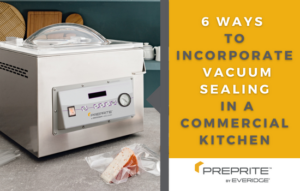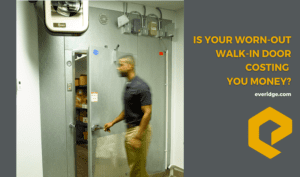Ask an Everidge Expert: Why is there frost in my walk-in freezer?

- February 23, 2018
We know you have questions, and Everidge experts are here to give you answers. Answering today’s question is John Stocks, Senior VP of Sales, Marketing and Construction Services for Everidge.
If you’re wondering why there’s frost in your walk-in freezer, the quick answer is that moisture is entering the freezer in some form. Lower levels of heat in a walk-in create an attraction for latent heat or moisture-laden air. Some frost is inevitable — as moisture is everywhere — but a consistent buildup is a problem.
Moisture can enter the freezer space in a number of ways. It could come from a warmer product being brought into the freezer, secondary strip curtains being damaged or missing, refrigeration system drains not operating properly, or the temperature differential (TD) on the evaporator coil being too high.
To determine where the moisture is coming from, the location of the frost can be a clue to the culprit.
- Ceiling/wall:
If frost buildup is on a ceiling or wall across from the evaporator, it’s likely that moisture is being retained in the evaporator — perhaps from drain line issues or a high TD. - Ceiling/corner with swirl pattern:
If the frost is on the ceiling or a corner and causing swirl patterns, it’s probably due to a lack of delay or another issue in the defrost cycle. Additionally, improper sealing of penetrations by the many trades involved with walk-in cooler/freezer space may add to this type of frosting. - Door:
Frost near the door is a clear sign the door is either not closing properly, or needs to have its seals adjusted or replaced. Freezer doors have heaters which must be maintained to effectively control frosting at doorways. - Penetrations (such as outlets):
All walk-in penetrations, including conduits and sprinklers, must be sealed both internally and externally in order to prevent moisture and frost buildup. Frost around one of these is a certain indication of a sealing problem.
But, the number one culprit of moisture getting in and causing a frost buildup is from the walk-in doors being left open.
We’ve had several owners ask for tips on how to persuade employees to stop leaving the walk-in doors open, and we’ve seen three approaches actually work: education, alarms and incentives. Educating associates on the importance of closing the doors can be effective when tying it to food safety and employee safety. Adding door alarms and flashing lights when doors stay open over 60 seconds is a useful tool that also adds a layer of protection and maintenance. Other employers have taken a different approach — placing temperature monitors in the walk-in and, when the temperature stays consistent, rewarding employees with incentives such as bonuses or vacation time. If your employees are consistently leaving the door open, give one of these strategies a try.
Note that “frost” typically refers to soft ice buildup. This soft buildup is an indication of available moisture, sure, but it can also be harmful by itself. The added moisture will make the system work harder, using more energy and ultimately reducing the functional life of the freezer. It can also cause physical damage, like scratches in metal surfaces leading to rust, and mold growing around improperly sealed doorways or connecting points. We recommend that you call a technician as soon as five days after the frost first appears to prevent it from becoming a major issue.
If you have a hard/clear ice buildup, it’s an indication that damage has already occurred due to outside air constantly leaking into the freezer. With hard buildup, your problems will be much more serious, as it can displace panels, doorways or evaporators and break drain lines. Hard buildup could be a result of a poorly insulated foundation, causing the panel tops to not contact the panel walls.
The good news is that most problems associated with frost can be prevented by responsible maintenance and an attentive staff. We recommend quarterly checks by a trained technician to keep your walk-in freezer investment well maintained. And Everidge offers extreme makeover solutions for a compromised freezer.
Have questions for an Everidge expert? Click here to ask your question, and it may be featured on our site.





![What you need to know before building a custom walk-in cooler [checklist] 4](https://www.everidge.com/wp-content/uploads/2019/01/4-300x177.png)




